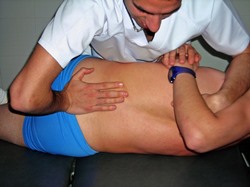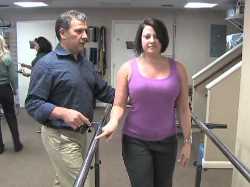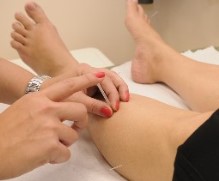How to Choose a Physical Therapist College near Belt 59412
 Getting a physical therapy degree near Belt MT is an important first step to beginning a fulfilling career in the healthcare industry. Physical therapists (PT) help people who have been incapacitated as a result of illness or injury gain back function and mobility. But before they may legally practice and provide treatment for the rehabilitation of patients, they must acquire the proper training and education. A PT must additionally become licensed in all states, a large number mandating that the licensee earn a physical therapy degree from an accredited college. So prior to selecting a physical therapy school, it’s necessary to research the ones you are considering to ensure they will supply a superior education and satisfy your state’s licensing requirements. What you do not want to do is enroll in a school just because it happens to be the nearest to your residence or it has the most affordable tuition. There are other important qualifications that need to be considered in addition to cost and location. But before we discuss what those qualifications are and the questions you should be asking, we’ll cover what a physical therapist does and what the educational options are.
Getting a physical therapy degree near Belt MT is an important first step to beginning a fulfilling career in the healthcare industry. Physical therapists (PT) help people who have been incapacitated as a result of illness or injury gain back function and mobility. But before they may legally practice and provide treatment for the rehabilitation of patients, they must acquire the proper training and education. A PT must additionally become licensed in all states, a large number mandating that the licensee earn a physical therapy degree from an accredited college. So prior to selecting a physical therapy school, it’s necessary to research the ones you are considering to ensure they will supply a superior education and satisfy your state’s licensing requirements. What you do not want to do is enroll in a school just because it happens to be the nearest to your residence or it has the most affordable tuition. There are other important qualifications that need to be considered in addition to cost and location. But before we discuss what those qualifications are and the questions you should be asking, we’ll cover what a physical therapist does and what the educational options are.
What is a Physical Therapist?
 Physical therapists practice in diverse locations, including Belt MT private practices, hospitals, assisted living facilities, rehab centers and health clubs. What the facilities all have in common is that they are equipped for the diagnosis and rehabilitation treatment of patients. As previously mentioned, physical therapists help individuals that are experiencing a lack of mobility and in many cases pain caused by injury or illness. After diagnosing a patient, they develop a program of treatment to resolve the mobility problems and lessen or eradicate any pain. They also try to stop any progression of the disability. While the causes of disability requiring physical therapy are numerous, they include:
Physical therapists practice in diverse locations, including Belt MT private practices, hospitals, assisted living facilities, rehab centers and health clubs. What the facilities all have in common is that they are equipped for the diagnosis and rehabilitation treatment of patients. As previously mentioned, physical therapists help individuals that are experiencing a lack of mobility and in many cases pain caused by injury or illness. After diagnosing a patient, they develop a program of treatment to resolve the mobility problems and lessen or eradicate any pain. They also try to stop any progression of the disability. While the causes of disability requiring physical therapy are numerous, they include:
- Arthritis or Osteoporosis
- Car or motor cycle accidents
- Head injuries.
- Heart attacks.
- Carpal Tunnel Syndrome.
- Burn injuries.
- Knee Replacement.
- Fibromyalgia.
- Multiple Sclerosis.
Licensed physical therapists practice in close affiliation with other Belt MT medical professionals, including chiropractors, physicians, registered nurses and dentists. They can also manage several physical therapy assistants who work under them assisting with diagnosing and treating their patients. One thing to keep in mind for anyone thinking about entering the physical therapy field, it is quite physically demanding. Physical therapists often lift patients and heavy equipment, and stand, crouch and kneel for extended periods of time on a daily basis.
Physical Therapy Degrees
 There are 3 physical therapist degree options available for students to enroll in at the undergraduate and graduate levels. Of these options, the one degree that is available to become a physical therapist is the doctorate. Undergraduate degrees emphasize either training students to become a physical therapy assistant (PTA) or preparing them to advance to the doctoral level. Following are short explanations of degree levels that are available in the Belt MT area:
There are 3 physical therapist degree options available for students to enroll in at the undergraduate and graduate levels. Of these options, the one degree that is available to become a physical therapist is the doctorate. Undergraduate degrees emphasize either training students to become a physical therapy assistant (PTA) or preparing them to advance to the doctoral level. Following are short explanations of degree levels that are available in the Belt MT area:
- Associate Degrees train students to be physical therapy assistants, or may be the first step toward earning a more advanced degree. Candidates must have earned a high school diploma or GED to be accepted for enrollment. The degrees are typically made available by junior or community colleges, and take about two years to complete. An internship or other form of clinical training is usually a portion of the program.
- Bachelor’s Degrees are designed as pre-physical therapist training to prep candidates to move up to the doctoral level. While they are not required to be qualified for the doctoral program, they are an integral preliminary step to practicing as a PT. Similar to most bachelor’s degrees, they generally take four years to finish and often include an internship program of at least 500 hours.
- Doctorate Degrees are mandated if you want to become a licensed practicing physical therapist. The degree program must also be accredited by the Commission on Accreditation in Physical Therapy Education (CAPTE). After earning the bachelor’s degree, the doctoral takes 3 years to complete, making the overall commitment 7 years in most cases. Clinical training is an essential element in addition to the extensive classroom and lab instruction. Consequently the completion of an internship is required, not solely for graduation but in several states for licensing as well.
The Doctor of Physical Therapy (DPT) has replaced the Master’s of Physical Therapy (MPT), which has been phased out and is no longer offered in the USA. A number of practicing physical therapists having a master’s or in some cases a bachelor’s degree were “grandfathered” in prior to the current licensing requirement for a doctorate was instituted.
Physical Therapist Online Degrees
 Although not as common as the more traditional alternatives, there are many accredited online physical therapy programs offered, even more at the graduate level. Due to the hands-on nature of the training, clinical lab work and internships are combined with the online classes. This requires that the student live close to the college campus or in proximity of a sponsored internship. Fortunately, the online portion of the course of study may be accessed within the comfort and convenience of the student’s Belt MT home. Online schools are not only partially more accessible, but in many instances more affordable. Tuition might be somewhat less than comparable on campus alternatives, and expenses for commuting are reduced. And a number of the online schools are accredited by the CAPTE, ensuring a quality education. These advantages can make the online alternative the best choice for those students that are disciplined enough to learn at home.
Although not as common as the more traditional alternatives, there are many accredited online physical therapy programs offered, even more at the graduate level. Due to the hands-on nature of the training, clinical lab work and internships are combined with the online classes. This requires that the student live close to the college campus or in proximity of a sponsored internship. Fortunately, the online portion of the course of study may be accessed within the comfort and convenience of the student’s Belt MT home. Online schools are not only partially more accessible, but in many instances more affordable. Tuition might be somewhat less than comparable on campus alternatives, and expenses for commuting are reduced. And a number of the online schools are accredited by the CAPTE, ensuring a quality education. These advantages can make the online alternative the best choice for those students that are disciplined enough to learn at home.
Questions to Ask Physical Therapy Colleges
By now you probably have made a decision regarding a few of your initial questions, such as the kind of physical therapist degree you intend to attain, where you prefer to attend classes, and how much money you can afford to spend for your education. But since there are so many PT colleges within the Belt MT area and throughout Montana, you’ll have to explore other qualifications as well so as to further narrow your list of school choices. Also, you need to make sure that you enroll in the college that is right for you. That’s the reason we have compiled a list of important questions that you must ask the physical therapist schools you are reviewing. Ask each of the competing schools these questions before making an ultimate selection.
Is the Physical Therapist School Accredited? Find out if the colleges you are looking at have earned accreditation from a regional or a national agency. As earlier stated, if you are pursuing a doctoral degree the program must be accredited by the Commission on Accreditation in Physical Therapy Education (CAPTE). If you choose an online college, it can also obtain accreditation from the Distance Education and Training Council. It’s imperative that both the physical therapy program and school you enroll in are accredited, not simply the school. Also, verify that the accreditation is through a U.S. Department of Education acknowledged accrediting agency. In addition to guaranteeing that you receive a quality education, accreditation may be mandated for state licensing and even for getting student loans or financial aid.
What is the Program’s Ranking? Along with accreditation, it’s important that the college and program you pick have excellent reputations within the physical therapy community. There are multiple ways you can research a PT program’s reputation, starting with asking for references from employers that they refer their students to. You may also check online reviews and rating services and ask the accrediting organizations for their reviews as well. Call a few Belt MT physical therapist clinics or other healthcare facilities that you may have an interest in working for and ask if they can offer any insight about your program options. It might also be prudent to check with the Montana Attorney General and school licensing authority to find out if any complaints have been filed against the schools.
What is the Program’s Job Placement Percentage? There are a couple of relevant statistics that you should find out about all of the physical therapist schools you are considering. First is their graduation rate. A low rate might suggest that students left due to dissatisfaction with the program, the teachers, or both. After the students have graduated, how many of them are being hired with the support of the school’s job placement program, particularly in the Belt MT area? If a college has a higher job placement rate, it suggests that its reputation within the medical care community is good or even excellent. It also confirms that the college has a large network of contacts to help students obtain internships or jobs after graduation.
Does the College Support Licensing Requirements? It’s imperative that the school you choose provides both exceptional training and a course of study that satisfies the licensing criteria for Montana or the state where you will be practicing. In each state a passing score is required on the National Physical Therapy Examination (NPTE) as well as a degree from an accredited physical therapist college. While licensing requirements vary state by state for PT and PTA graduates, many states require a minimum number of clinical hours be completed and passing scores on additional exams.
Are Internships Sponsored? Inquire if the physical therapist programs you are interested in have associations with Belt MT clinics or hospitals for internship programs. Internships are not only an excellent way to receive hands on training in a clinical setting, they are additionally a requirement for the majority of PT programs and state licensing. As a supplemental benefit, they can assist students and graduates establish professional relationships in the Belt medical community and help with job placement after licensing.
How Big are the Classes ? Unless you are the kind of person that likes to sit far in the rear of the classroom or get lost in the crowd, you will likely want a smaller class size. Small classes allow for more individual participation and personalized instruction. Ask the physical therapy schools you are considering what the average teacher to student ratio is for their classrooms. If practical you may want to sit in on one or more classes before making your final determination. This will also give you a chance to speak with a few of the instructors and students to get their perspectives regarding the pharmacist technician program as well.
Where is the Program Located? For a number of students, the physical therapist college they decide on will need to be within commuting distance of their Belt MT residence. Individuals who have chosen to attend online classes obviously will not have to trouble themselves with the location of the campus. However, the availability of area internships will be of concern. Something to keep in mind is that if you decide to enroll in a school that is out of state or perhaps out of your local area, you may be required to pay a higher tuition. State colleges commonly charge higher tuitions for out of state residents. And community colleges normally charge a higher tuition to those students that don’t reside within their districts.
Is Financial Assistance Offered? Most DPT schools offer some form of financial assistance to their prospective students. Find out if the colleges you are examining have a financial aid office and see what kind of assistance is available. They at least should help in obtaining a student loan or any scholarships you may be eligible for. Some physical therapist colleges offer scholarships, while others offer work programs. So before eliminating a college because the tuition is beyond your budget, find out what financial assistance may be available.
Can the College Accommodate your Schedule? And last you need to verify that the physical therapy school you ultimately select can provide the class schedule you need. This is particularly crucial if you opt to continue working while attending classes. If you must schedule evening or weekend classes in the Belt MT area, verify that they are available. If you can only attend part-time, find out if that is an alternative and how many credit hours or courses you would need to enroll in. Also, ask what the protocol is for making up any classes that you might miss as a result of work, illness or family obligations.
Earning Your Physical Therapy Degree near Belt Montana?
If you are planning on attending a Physical Therapy School in the Belt MT area, the following information may prove to be both interesting and educational regarding the location of your future Alma Mater.
Belt, Montana
Belt is located at 47°23′9″N 110°55′36″W / 47.38583°N 110.92667°W / 47.38583; -110.92667 (47.385935, -110.926587).[7] According to the United States Census Bureau, the town has a total area of 0.35 square miles (0.91 km2), all of it land.[1]
As of the census[2] of 2010, there were 597 people, 261 households, and 159 families residing in the town. The population density was 1,705.7 inhabitants per square mile (658.6/km2). There were 295 housing units at an average density of 842.9 per square mile (325.4/km2). The racial makeup of the town was 95.5% White, 1.7% Native American, 0.5% Asian, 0.2% from other races, and 2.2% from two or more races. Hispanic or Latino of any race were 1.0% of the population.
There were 261 households of which 29.1% had children under the age of 18 living with them, 47.5% were married couples living together, 10.7% had a female householder with no husband present, 2.7% had a male householder with no wife present, and 39.1% were non-families. 33.0% of all households were made up of individuals and 13.7% had someone living alone who was 65 years of age or older. The average household size was 2.29 and the average family size was 2.92.
Enroll in the Best Physical Therapist Degree Program near Belt MT
Deciding on the right physical therapist school is a necessary initial decision you must make to launch a fulfilling career in the medical profession. As we have addressed in this article, the PT or DPT degree program and school you select should both have outstanding reputations and accreditation. However there are other important questions that you should ask concerning your college of choice also. As you commence your search for a physical therapist college, keep in mind that a number of factors will lead you to your ultimate decision. You may decide to visit different colleges to view their facilities and talk with current DPT students. While there, ask yourself this important question: will this school help me realize my goal of becoming a licensed practicing physical therapist? By adhering to our list of supplemental questions, you will have the ability to narrow down the options so you can make the best choice. And with the proper education and training, you can accomplish your dream to become a licensed physical therapist in Belt MT.
A Few More Interesting Locations in Montana




